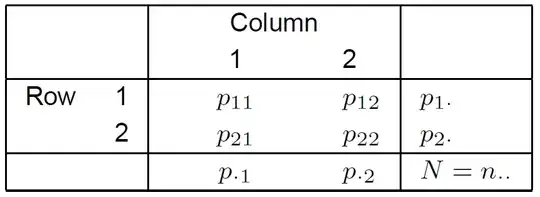Here is the derivation. I use the same notation as in this presentation (starting from page 29). Let's look at the familiar $2\times2$-Table below.

The relative risk or risk ratio is defined as
$$
\theta=\mathrm{RR}=\dfrac{\dfrac{p_{11}}{p_{11}+p_{12}}}{\dfrac{p_{21}}{p_{21}+p_{22}}}=\dfrac{p_{11}\cdot (p_{21}+p_{22})}{p_{21}\cdot (p_{11}+p_{12})}
$$
We want to derive the variance of $\theta$. The multivariable version of the delta method is:
$$
\mathrm{Var}(\hat{\theta})\approx \nabla f(p_{11}, p_{12}, p_{21}, p_{22})\cdot \mathrm{Cov}(p_{11}, p_{12}, p_{21}, p_{22})\cdot \nabla f(p_{11}, p_{12}, p_{21}, p_{22})^{T}
$$
Where $\nabla$ is the gradient vector. That is:
$$
\nabla f(p_{11}, p_{12}, p_{21}, p_{22}) = \left(\frac{\partial f}{\partial\,p_{11}}, \ldots,\frac{\partial f}{\partial\,p_{22}}\right)
$$
We want to estimate
$$
\mathrm{Var}(\log(\mathrm{RR}))=\mathrm{Var}\left[\log\left(\frac{p_{11}\cdot (p_{21}+p_{22})}{p_{21}\cdot (p_{11}+p_{12})}\right)\right]
$$
Let the function $f$ be
$$
f = \left[\log(p_{11}) + \log(p_{21}+p_{22}) - \log(p_{21}) - \log(p_{11}+p_{12})\right]
$$
The gradient $\nabla f$ is
$$
\nabla f = \left(\frac{p_{12}}{p_{11}^{2}+p_{11}p_{12}},-\frac{1}{p_{11}+p_{12}},-\frac{p_{22}}{p_{21}^{2}+p_{21}p_{22}}, \frac{1}{p_{21}+p_{22}}\right)
$$
The variance covariance matrix for a multinomial distribution with $c=4$ categories is
$$
\Sigma=\frac{1}{n}\left(
\begin{array}{cccc}
\left(1-p_{11}\right) p_{11} & -p_{11} p_{12} & -p_{11} p_{21} & -p_{11} p_{22} \\
-p_{11} p_{12} & \left(1-p_{12}\right) p_{12} & -p_{12} p_{21} & -p_{12} p_{22} \\
-p_{11} p_{21} & -p_{12} p_{21} & \left(1-p_{21}\right) p_{21} & -p_{21} p_{22} \\
-p_{11} p_{22} & -p_{12} p_{22} & -p_{21} p_{22} & \left(1-p_{22}\right) p_{22} \\
\end{array}
\right)
$$
Then $\nabla f\,\Sigma$ equals
$$
\nabla f\,\Sigma=\frac{1}{n}\times \left[\frac{p_{12}}{p_{11}+p_{12}}, -\frac{p_{12}}{p_{11}+p_{12}}, -\frac{p_{22}}{p_{21}+p_{22}}, \frac{p_{22}}{p_{21}+p_{22}}\right]
$$
Now we need $(\nabla f\,\Sigma)\times \nabla f^{T}$ which equals:
$$
(\nabla f\,\Sigma)\times \nabla f^{T}=\frac{1}{n}\times \left[-\frac{1}{p_{11}+p_{12}}+\frac{1}{p_{21}}-\frac{1}{p_{21}+p_{22}}+\frac{1}{p_{11}}\right]
$$
Substituting the MLEs for $\widehat{p_{ij}}=n_{ij}/n$ finally yields
$$
\widehat{\mathrm{Var}(\log(\mathrm{RR})}=\left(\frac{1}{n_{11}}+\frac{1}{n_{21}}\right)-\left(\frac{1}{n_{11}+n_{12}}+\frac{1}{n_{21}+n_{22}}\right)
$$
So the approximative standard error for the relative risk on the log-scale is
$$
\widehat{\mathrm{SE}(\log(\mathrm{RR})}=\sqrt{\widehat{\mathrm{Var}(\log(\mathrm{RR})}}=\sqrt{\left(\frac{1}{n_{11}}+\frac{1}{n_{21}}\right)-\left(\frac{1}{n_{11}+n_{12}}+\frac{1}{n_{21}+n_{22}}\right)}
$$
So an approximative two-sided confidence interval of level $\alpha$ for the relative risk on the original scale is
$$
\mathrm{CI}=\exp(\log(\mathrm{RR})\pm z_{1-\alpha/2}\times \mathrm{SE}(\log(\mathrm{RR}))
$$
